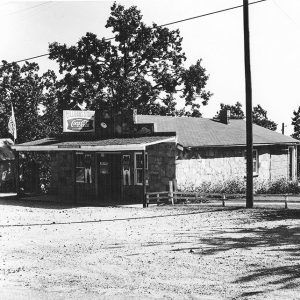calsfoundation@cals.org
Oakland (Marion County)
Oakland is a populated unincorporated community in North Fork Township on State Highway 202 about twenty miles northwest of Mountain Home (Baxter County). Once a small village near the Little North Fork River’s confluence with the White River, Oakland was moved a few miles east in the late 1940s when the White was being dammed to create Bull Shoals Lake.
The area was hunting territory of the Osage and earlier tribes, and archaeologists working at Oakland in 1948–1949 found possible evidence of small villages from the Woodland and Mississippian periods. White settlers—including the Yocham, Trimble, Coker, Graham, and McGarrah families—arrived in the 1810s. The explorer Henry Schoolcraft stayed overnight at the McGarrahs’ cabin in December 1818 and was given food from their smokehouse, which was filled with bear and buffalo meat.
Near the mouth of the Little North Fork around 1820, Jacob Friend built Friend’s Mill, which also served as the township meeting and election site. Little North Fork Church was built nearby in 1829. The area was slowly settled by farmers over the next decades. The White River bottomlands, where cotton, corn, and other crops could be easily grown, were occupied first. A small number of slaves worked on a few of the farms. Free biracial men David Hall and Martin Turner owned their own farms in the area by 1830. According to the 1850 federal slave schedule, Michael Yokum, who had become the mill owner, owned ten slaves, the most of anyone in the area at that time. After the Civil War, small farms were started in the adjacent wooded hills.
By the early 1880s, a hamlet began to form on Orcutt Flat (named for settler Augustus Orcutt), one mile south of the Little North Fork. The site was at a midway point on the road between Flippin (Marion County) and Isabella, Missouri. Around 1880, a school/church building was erected, and the first store was set up by a Dr. Lewis. Other early businesses included Franklin Norton’s general store, Dr. Abe McVey’s drugstore, the Griffin & Noe’s store, and George Layton’s blacksmith and wagon shop.
A post office called Noe’s Ferry, or simply Noe’s, was relocated to Orcutt Flat. Earlier, this post office (also known locally as Pierson, its postmaster’s name) had been in operation farther downriver on the White. The name was changed from Noe’s to Oakland in 1886. The new name, many believe, was derived from the area’s abundance of oak trees. Besides farm crops, the main products at this time included oak timber used for railroad ties and lumber.
Oakland’s population decreased somewhat after the turn of the century. A new railroad through Flippin shifted local trade, and some residents moved to southern Marion County to work at the large lead and zinc mines. The Oakland area had a few small lead mines and, by 1915, a mussel-shell button factory. Sam Martin’s general store became the main business. A new schoolhouse was built with the help of federal funds in 1937.
Construction of Bull Shoals Dam on the White River began in 1947. The village would be under water and so was moved a few miles to the Hill Top community, earlier known as Fears. Old Oakland’s buildings were dismantled, demolished, or moved. The remains of the deceased in the cemeteries were reinterred at a new Oakland Cemetery on Highway 5 in Baxter County.
By 1950, a new general store (with a post office), a gas station, and a mechanic shop were built. Material from the old schoolhouse was used to construct the new one-room Oakland School. This was the last one-room school in use in Arkansas when it closed in 1974. Baptist mission services were held in an existing building east of Oakland until 1966 when Hilltop Baptist Church was constructed west of Oakland School.
The new lake separated Oakland from the rest of Marion County, making the drive to the county seat considerably longer. There has been at least one unsuccessful proposal to make the area a part of Baxter County because its county seat would be closer.
Bull Shoals Lake’s clear water attracted fishing enthusiasts and other tourists, prompting the establishment of about fifteen resorts, some restaurants, and a marina. The U.S. Army Corps of Engineers built campsites and boat ramps at Oakland Park and Ozark Isle Park.
The Oakland Area Improvement Association was organized in 1971, and the Oakland Community Center building was completed in 1974. The center also eventually housed the Oakland Post Office and the Oakland Library.
Members of the rock band Black Oak Arkansas and their families lived in Oakland in the 1970s. The band paid for most of the 1975 construction of a larger elementary school, which was needed to meet new state requirements. The final school year at Oakland was 1985–1986, after which its students attended Mountain Home schools, as the high school students had already been doing, due to school consolidation.
In 1985, about two miles north of Oakland, hundreds of law enforcement officers raided the compound of the militia-style survivalist group known as the Covenant, the Sword and the Arm of the Lord. Several members were charged with racketeering, conspiracy, and illegal weapons possession.
The community’s main businesses in the twenty-first century include resorts and a marina. Many Oakland residents are retirees.
For additional information:
Berry, Earl. History of Marion County. Yellville, AR: Marion County Historical Society, 1977.
Bodenhamer, Jim. “Time’s Running Out for Oakland’s One-Room School.” Baxter Bulletin, May 9, 1974, pp. 1B, 2B.
Nelson, Gary. “Oakland, Arkansas: Prehistory and History.” On file at Oakland Library, Oakland, Arkansas.
Gary Nelson
Oakland, Arkansas
 Marion County Map
Marion County Map  Milligan's Store
Milligan's Store 



Comments
No comments on this entry yet.